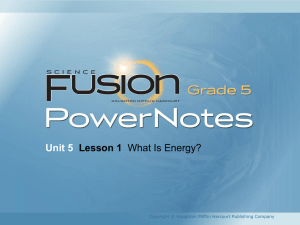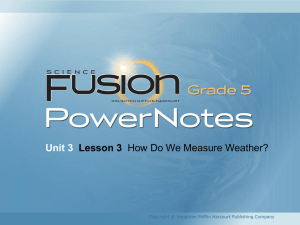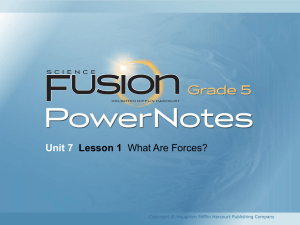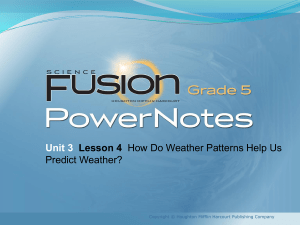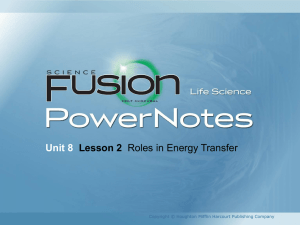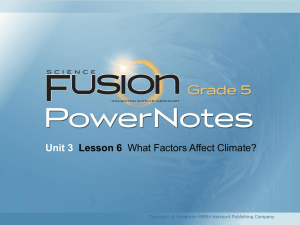Unit 3 Lesson 1
advertisement
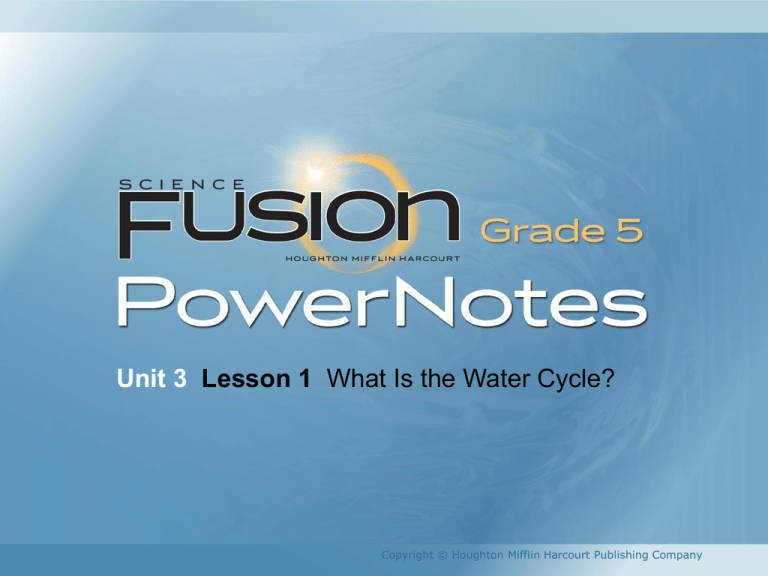
Unit 3 Lesson 1 What Is the Water Cycle? Copyright © Houghton Mifflin Harcourt Publishing Company Unit 3 Lesson 1 What Is the Water Cycle? Florida Benchmarks • SC.5.E.7.1 Create a model to explain the parts of the water cycle. Water can be a gas, a liquid, or a solid and can go back and forth from one state to another. • SC.5.E.7.2 Recognize that the ocean is an integral part of the water cycle and is connected to all of Earth’s water reservoirs via evaporation and precipitation processes. Copyright © Houghton Mifflin Harcourt Publishing Company Unit 3 Lesson 1 What Is the Water Cycle? Water on the Move • About 75 percent of Earth’s surface is covered by water. • Water moves between Earth’s surface and the atmosphere in a process called the water cycle. • The sun provides the energy needed for water to move in the water cycle. Copyright © Houghton Mifflin Harcourt Publishing Company Unit 3 Lesson 1 What Is the Water Cycle? Water on the Move • Evaporation is the change from a liquid to a gas. • The sun causes water to evaporate. • When water evaporates, it forms an invisible gas called water vapor. Copyright © Houghton Mifflin Harcourt Publishing Company Unit 3 Lesson 1 What Is the Water Cycle? Water on the Move • The atmosphere is the mixture of gases that surrounds Earth. • Water vapor from evaporation rises into the atmosphere. • Water vapor cools in the atmosphere to form clouds. Copyright © Houghton Mifflin Harcourt Publishing Company Unit 3 Lesson 1 What Is the Water Cycle? What Goes Up Comes Down Condensation • As water vapor cools, it loses heat energy to condense into liquid water. • Condensation is the change of a gas into a liquid. Copyright © Houghton Mifflin Harcourt Publishing Company Unit 3 Lesson 1 What Is the Water Cycle? Condensation • When water vapor condenses around tiny particles of salt and dust in the atmosphere, clouds can form. Copyright © Houghton Mifflin Harcourt Publishing Company Unit 3 Lesson 1 What Is the Water Cycle? Precipitation • Clouds can contain liquid water or ice. • Precipitation is water that falls from clouds to Earth’s surface. • Forms of precipitation include rain, snow, and hail. Copyright © Houghton Mifflin Harcourt Publishing Company Unit 3 Lesson 1 What Is the Water Cycle? Precipitation • Precipitation that falls into the ocean can be evaporated again quickly. • Precipitation that falls on land may be temporarily stored. • Depending on where it falls, water from precipitation may move quickly or slowly through the water cycle. Copyright © Houghton Mifflin Harcourt Publishing Company Unit 3 Lesson 1 What Is the Water Cycle? Where Does Water Go? • When precipitation occurs, some water can reenter the atmosphere right away. • Some water may be stored underground. • Water that is stored underground is called groundwater. Copyright © Houghton Mifflin Harcourt Publishing Company Unit 3 Lesson 1 What Is the Water Cycle? Where Does Water Go? • How does precipitation get into the ground to become groundwater? Copyright © Houghton Mifflin Harcourt Publishing Company Unit 3 Lesson 1 What Is the Water Cycle? Where Does Water Go? • Runoff is water that cannot soak into the ground and instead flows across Earth’s surface. • Water flows downhill into low-lying areas, rivers, and streams. • Once runoff enters a river, it flows toward an ocean or lake. Copyright © Houghton Mifflin Harcourt Publishing Company Unit 3 Lesson 1 What Is the Water Cycle? Where Does Water Go? • Precipitation that falls in cold places may become part of a glacier. • A glacier is a large, slow-moving mass of ice. • Melting snow and ice can cause an increase in the amount of runoff in an area. Copyright © Houghton Mifflin Harcourt Publishing Company Unit 3 Lesson 1 What Is the Water Cycle? Where Does Water Go? • Describe what is happening in the diagram. Copyright © Houghton Mifflin Harcourt Publishing Company Unit 3 Lesson 1 What Is the Water Cycle? A Precious Resource • Fresh water can come from rivers, lakes, and aquifers. • An aquifer is a body of rock that stores groundwater. • The water in an aquifer can run low or be polluted by human activities. Copyright © Houghton Mifflin Harcourt Publishing Company Unit 3 Lesson 1 What Is the Water Cycle? A Precious Resource • Which other states use the Floridan aquifer system? Copyright © Houghton Mifflin Harcourt Publishing Company Unit 3 Lesson 1 What Is the Water Cycle? A Precious Resource • People cannot live without water. • Precipitation adds water to aquifers in places called recharge zones. • It may take groundwater in an aquifer up to a year to travel only 25 cm. Copyright © Houghton Mifflin Harcourt Publishing Company

